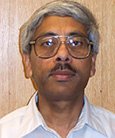Manohar Das, Ph.D.
 |
Professor Electrical and Computer Engineering Department 424 EC; (248) 370-2237 ; Fax: (248) 370-4633 [email protected] |
Education
Ph.D. (Colorado State University, 1984)
Professional Association
IEEE, ASEE, Eta Kappa Nu, Sigma Xi
Teaching
- Digital Signal Processing
- Communication Systems
- Power Electronics
- Signals and Systems
- System Optimization
Research
Adaptive control and signal processing; Modeling, Optimum charging and management of Li-ion batteries; System modeling and identification; Digital signal and image processing; Data compression; Pattern recognition; Optimization.
Selected Publications
1. Lubna Khasawneh and Manohar Das, Real Time Estimation of Road Bank Disturbance and Vehicle Side Slip Angle, International Journal of Intelligent Transport Systems Research (Springer), 2022.
2. Lubna Khasawneh and Manohar Das, A Robust Electric Power-Steering-Angle Controller for Autonomous Vehicles with Disturbance Rejection, Electronics, 2022, 11(9), 1337; https://doi.org/10.3390/electronics11091337.
3. Saad Jarid and Manohar Das, An Optimal Fast Charging Scheme for Li-ion Batteries Using a Continuous Exponentially Decaying Current Profile, Proceedings of 2022 IEEE Electro Information Technology Conference, May, 2022.
4. Saad Jarid and Manohar Das, An Electro-Thermal Model based fast optimal charging strategy for Li-ion batteries, AIMS Energy, 2021, Volume 9, Issue 5, pp. 915-933.
5. Ziyad Kas and Manohar Das, Adaptive Control of Resistance Spot Welding Based on a Dynamic Resistance Model, Journal of of Mathematical and Computational Applications, 2019, 24(4), 86; https://doi.org/10.3390/mca24040086; Pub. MDPI, Basel, Switzerland.
6. Ashraf Mostafa and Manohar Das, A Study of Recursive Techniques for Robust Identification of Time-Varying Electrical Equivalent Circuit Models of Li-ion Batteries, International Journal of Handheld Computing Research, Volume 8, Issue 3, 2018.
7. Robert N.K. Loh and Manohar K. Das, Nonlinear Unknown‐Input Observer‐Based Systems for Secure Communication, Advances in Underwater Acoustics, Dr. Andrzej Zak (Ed.), pub. InTech, 2017, pp. 45-73. DOI: 10.5772/intechopen.69239.
8. Ziyad Kas, Manohar Das, An Electrothermal Model Based Adaptive Control of Resistance Spot Welding Process, Intelligent Control and Automation, June 2015, pp. 134-146.
9. Arab AlSharif and Manohar Das, A Piecewise Linear Time-Varying Model for Modeling the Charging and Discharging Processes of a Lithium-Ion Battery, International Journal of Handheld Computing Research, 5(2), 101-119, June 2014, pp. 101-119.
10. Edward Gu and Manohar Das, “Backstepping Control Design for Vehicle Active Restraint Systems,” ASME Transactions on Dynamic Systems, Measurements and Control, 2013.
11. Gurunath Kedar-Dongarkar and Manohar Das, “Driver Classification for Optimization of Energy Usage in a Vehicle,” Proceedings of 2012 Conference on Systems Engineering Research, St. Louis, Missouri, March, 2012.
12. Yixin Chen, Manohar Das, Devendra Bajpai, “Vehicle Tracking and Distance Estimation Based on Multiple Image Features,” Proceedings of 2007 Canadian Conference on Computer and Robot Vision.
Patents
1. US Patent issued, US 9421634 B2 (Issued on August 23, 2016). Title: System and method for performing resistance spot welding. Inventors: Manohar Das, Vernon Fernandez, John Paille, Douglas P Gouin. Original Assignee: FCA, USA.
2. US Patent No. US8445809 B2 (Issued on May 21, 2013). Title: Method and apparatus for resistance spot welding. Inventors: Vernon Fernandez, Manohar Das, Gerald Grzadzinski. Original Assignee: FCA, USA.
3. US Patent No. US7244905 B2 (Issued on July 17, 2007). Title: Method For Estimating Nugget Diameter And Weld Parameters. Inventors: Manohar Das, Vernon Fernandez, James Strausbaugh, and Gerald Grzadzinski. Original Assignee: FCA, USA.
4. US Patent No. US6130956 B2 (Issued on October 10, 2000). Title: Continuous Microbiotal Recognition Method. Inventors: Francis M. Butterworth and Manohar Das.
Doctoral Dissertations Supervised
• Robust and Adaptive Lateral Controller for Autonomous Vehicles, Lubna Khasawneh, 2022.
• Ziyad R. Kas, Modeling and Adaptive Control of Resistance Spot Welding Process, Ph. D. dissertation, 2016.
• Predictive Learning Based Hybrid Vehicle Powertrain Optimization, Gurunath S. Kedar-Dongarkar, 2015.
• Adaptive Time Series Modeling of Charging and Discharging Processes of Lithium-Ion Batteries and Applications in Battery Management Systems, Arab Al-Sharif, 2015.
• Adaptive Control of Indoor Temperature in a Building, Sumera I Chaudhry, 2014.
• A New Hybrid Adaptive Predictive Technique for Data Compression, Radhakrishnan Swaminathan, 2012.
• Real Time Control of an Adaptive Vehicular Occupant Restraint System Using Intelligent Control Techniques, Mohannad Murad, 2009.
• New techniques for Image De-noising, Thresholding, Object Detection and their Application to Vision Based Collision Avoidance System, Yixin Chen, 2008.
• Adaptive Modeling in Lossless Image Compression, Abdul-Rahman Itani, 2005
• Robust Algorithms For Engine Misfire Detection, Abedulah Alkhateeb, 2003.
• Identification of Waterborne Micro-Organisms Using Motion Characteristics, Devendra Bajpai, 2003.
• High Capacity Information Hiding in Images, Johann Briffa, 2003.
• A Mixture Modeling Approach to Engine Misfire Detection, Nashat K. A. Jalil, 2002.
• Classification of Spot Welds from a Linear Time-Varying Model of the Resistance Signature, Frank Garza, 2001.
• New Adaptive and Optimal Control Strategies for Active Noise Cancellation in a One-Dimensional Acoustic Duct, Ananth Krishnan, 2001.
• The Classification and Detection of Anomalies in Digitally Sampled Dynamic Data, Thomas Hunt, 2000.
• New Multipulse Excitation Method for the Modeling, Coding and Synthesis of Automotive Acoustic Events, Scott Amman, 1997.
• Techniques for the Detection of Changes in Noisy Signals with Application to Fault Detection in Dynamic Systems, Anthony Cooprider, 1997.
• Image Restoration and Compression Using Two-Dimensional Predictive Models, Jayraman Anand, 1997.
• Lossless and Near-Lossless Compression of Digitized Images, Chi-Dar Lin, 1996.
• Multiresolution Autoregressive Models for Image Compression, Shape Classification, and Texture Synthesis. Chia Che Li, 1995.
• New Approaches for Control of Slowly Varying Systems, Pradeep Y. Kokate, 1992. (Co-advised with Professor N. K. Loh)
• Predictive Image Coding Using Two Dimensional Multiplicative Autoregressive Models, Scott R. Burgett, 1991.
• Analysis and Classification of Planar Shapes and Textures, Mark J. Paulik, 1989. (Co-advised with Professor N. K. Loh)
School of Engineering and Computer Science
115 Library Drive
Rochester , MI 48309-4479
(location map)
Dean's Office (248) 370-2217
Academic Advising (248) 370-2201
[email protected]







